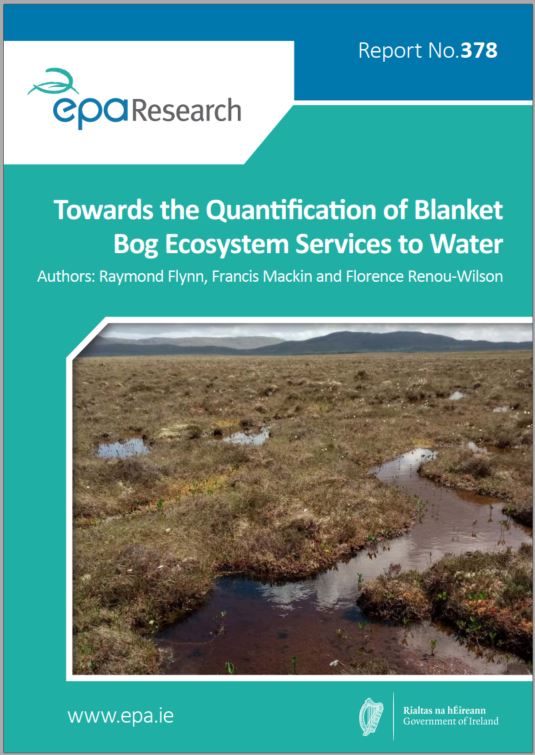Research 378: Towards the Quantification of Blanket Bog Ecosystem Services to Water
Authors: Raymond Flynn, Francis Mackin and Florence Renou-Wilson
Summary: Blanket bogs are common in many areas of Ireland, contributing to our most iconic landscapes. However, although they cover approximately 13% of the country, natural processes sustaining blanket bogs remain poorly understood. This research aimed to better understand blanket bog hydrology through a 3-year programme in which researchers monitored the flow and water quality in streams draining Irish blanket bogs that are relatively intact.

Project Highlights
Watch the project highlights video
Identifying Pressures
Blanket bogs are common in many areas of Ireland, contributing to some of our most iconic landscapes. However, although they cover approximately 13% of the country, natural processes sustaining blanket bogs remain poorly understood. This lack of knowledge includes an underappreciation of the natural capital that they contain and the ecosystem services that they provide to society. Failure to appreciate the wider benefits provided by blanket bogs has resulted in many blanket bogs being altered for alternative uses that generate marketable products such as fuel, meat and timber. Some of these activities involve installing artificial drainage, which can negatively affect bog hydrology (or how water behaves). This can have an impact on bog vegetation, flow in streams and water quality. Moreover, damage to blanket bog hydrology can have significant economic knock-on effects, ranging from an increased risk of flooding downstream to higher water treatment costs and reduced water security. However, assigning costs to these effects has been complicated by a lack of information on how blanket bogs behave naturally and how much human activities have altered natural processes.
Informing Policy
The EPA-funded project Towards the Quantification of Blanket Bog Ecosystem Services to Water (QUBBES) aimed to better understand blanket bog hydrology through a 3-year programme in which researchers monitored the flow and water quality in streams draining Irish blanket bogs that are relatively intact. Using the information that has been collected and comparing conditions with those streams collecting water from areas containing more damaged bog, allows the value of intact blanket bogs to be more confidently determined, while also allowing the economic benefits of conservation and peatland restoration programmes to be better defined. The importance of these issues has proven particularly relevant for Ireland, given its strong dependence on peat-covered areas for water supply. Although not all ecosystem services can be economically costed, providing values to those that can allows for a better understanding of the wider cost of developments on blanket bogs, while also giving us an appreciation of the wider economic value of blanket bogs to society.
Developing Solutions
Information collected during the QUBBES project suggested that, compared with damaged sites, the flow in streams draining the more intact blanket bogs studied displayed greater stability and/or less variable water quality, particularly during prolonged dry periods. More limited data indicated that more degraded areas were associated with higher flood risk. Economic analysis of the wider benefits of blanket bog development proved challenging, as specific information concerning underpinning costs proved hard to come by. However, a case study comparing the effects of development on ecosystem services in a drained and undrained area of bog demonstrated that water coming from the developed area had greater water treatment costs and higher flood risk. The results, when considered with additional losses of greenhouse gases from degrading peat, suggested that failing to incorporate ecosystem services provided by bogs generated an unrealistic picture of economic benefits of conventional developments, and that maintaining/restoring blanket bog to its natural (peat-accumulating) condition may be more viable. This information provides a strong economic case for Irish blanket bog conservation and restoration programmes.
https://www.epa.ie/media/epa-2020/research/epa-funded-research/Report_Cover_378.jpg